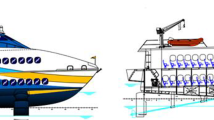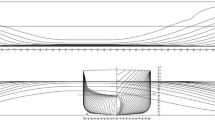Abstract
The hydrofoil is a craft where the weight is entirely supported by the lift generated by the submerged part of wings. The particular structure of the craft requires a thorough study of the architecture of the hull, whose structure differs from others high speed vessels since the lift on wing surfaces are transmitted to the hull in limited areas (wing attacks). The authors have developed a research to optimize geometry of hull and wing system on a hydrofoil capable to carry 250 passengers at a speed of 35 knots, operating among Sicilian island. The principal goals of the new hydrofoil concern both the fuel reduction that the improvement of the comfort in terms of seakeeping and levels of acoustic vibrations. In order to reduce the power engines and the acoustic vibrations and to increase the seakeeping during the cruising route and the takeoff, a thorough study of the bow sections (whose profile contributes during this step to exert a thrust which, added to that provided by the wing surfaces, drastically reduces takeoff times) is conducted. Several experimental tests, performed at the towing tank, have allowed to better define the shapes of the hydrofoil and the profile of the wings. An economic assessment was carried out in order to demonstrate that the innovation effort contributes to reducing both construction that operating costs.


















Similar content being viewed by others
References
Cannizzaro, L., Giallanza, A., Marannano, G.V., Muraca, E., Palladino, M.: Dual compensation control-system for offshore logistic equipment. In: 17th International Conference on Ships and Shipping Research - NAV 2012, Naples (Italy) (2012)
Giallanza, A., Marannano, G.V., Pasta, A.: Structural optimization of innovative rudder for HSC. In: 17th International Conference on Ships and Shipping Research - NAV 2012, Naples (Italy) (2012)
Fragapane, S., Giallanza, A., Cannizzaro, L., Pasta, A., Marannano, G.: Experimental and numerical analysis of aluminum-aluminum bolted joints subject to an indentation process. Int. J. Fatigue 80(6), 332–340 (2015)
Marannano, G., Pasta, A., Parrinello, F., Giallanza, A.: Effect of the indentation process on fatigue life of drilled specimens. J. Mech. Sci. Technol. 29(7), 2847–2856 (2015)
Marannano, G., Parrinello, F., Giallanza, A.: Effects of the indentation process on fatigue life of drilled specimens: optimization of the distance between adjacent holes. J. Mech. Sci. Technol. 30(3), 1119–1127 (2016)
Marannano, G., Pasta, A., Giallanza, A.: A model for predicting the mixed-mode fatigue crack growth in a bonded joint. Fatigue Fract. Eng. Mater. Struct. 37(4), 380–390 (2014)
Ruggiero, V., Morace, F.: Comparative test in design of hydrofoils for a new generation of ships. In: 19th International Conference on Ships and Shipping Research - NAV 2018, Trieste (Italy), pp. 418–425 (2018)
Ruggiero, V., Morace, F.: Methodology to study the comfort implementation for a new generation of hydrofoils. Int. J. Interact. Des. Manuf. 13(1), 99–110 (2019)
Cirello, A., Cucinotta, F., Ingrassia, T., Nigrelli, V., Sfravara, F.: Fluid–structure interaction of downwind sails: a new computational method. J. Mar. Sci. Technol. 24(1), 86–97 (2019)
Cucinotta, F., Nigrelli, V., Sfravara, F.: A preliminary method for the numerical prediction of the behavior of air bubbles in the design of Air Cavity Ships. Advances on Mechanics, Design Engingeering and Manufacturing. Lecture notes in Mechanical Engineering, Catania (Italy), pp. 509–516 (2016)
Van Oossanen, P., Heimann, J., Henrichs, J., Hochkirch, K.: Motor yacht hull form design for the displacement to semi-displacement speed range. In: 10th International Conference on Fast Sea Transportation - FAST 2009, Athens (Greece) (2009)
Savitsky, D.: Hydrodynamic design of planning hull. Mar. Technol. 1, 71–95 (1964)
Trincas, G., Mauro, F., Braidotti, L., Bucci, V.: Handling the path from concept to preliminary ship design. In: 13th International Marine Design Conference - IMDC 2018. Espoo (Finland), 1, pp. 181–192 (2018)
Acknowledgements
This study is conducted by means of PON01_01605 project financed by Ministero dell’Istruzione, dell’Università e della Ricerca—“Piano Operativo Nazionale Ricerca e Competitività 2007–2013”.
Author information
Authors and Affiliations
Corresponding author
Additional information
Publisher's Note
Springer Nature remains neutral with regard to jurisdictional claims in published maps and institutional affiliations.
Rights and permissions
About this article
Cite this article
Giallanza, A., Marannano, G., Morace, F. et al. Numerical and experimental analysis of a high innovative hydrofoil. Int J Interact Des Manuf 14, 43–57 (2020). https://doi.org/10.1007/s12008-019-00616-0
Received:
Accepted:
Published:
Issue Date:
DOI: https://doi.org/10.1007/s12008-019-00616-0




